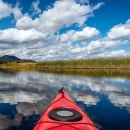Visit Us
The Tetlin National Wildlife Refuge is a “must see” on your list of stops in Alaska. If you are driving into the state from the south on the Alaska Highway, you can’t miss it! As soon as you cross the border, the Refuge boundary is adjacent to the south side of the highway for almost 65 miles. Find your adventure with us!
Location and Contact Information
- Tetlin National Wildlife Refuge Visitor CenterView DetailsMile 1.3 Borealis Avenue Tok, AK 99780
Our Organization
Our Species
- Tetlin Refuge supports at least 42 species of mammals.
- The Refuge provides habitat for 30 resident and 96 migratory bird species that stop and breed on the refuge.
- There are 15 species of fish known to occur on the Refuge.
- Only one amphibian, the wood frog (Rana sylvtica), is found in on the refuge.
Projects and Research
We have several active projects. The Lynx Project is a collaboration between the U.S. Fish and Wildlife Service, the University of Alaska Fairbanks, and the National Park Service. We are also studying humpback whitefish and are involved with regional efforts to detect, manage, and control invasive species invasive species
An invasive species is any plant or animal that has spread or been introduced into a new area where they are, or could, cause harm to the environment, economy, or human, animal, or plant health. Their unwelcome presence can destroy ecosystems and cost millions of dollars.
Learn more about invasive species in Alaska.























